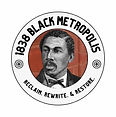What Resistance looked like in 1838
- Michiko

- May 25, 2023
- 4 min read
Updated: Aug 3, 2024
Someone asked me recently when was it that I became passionate about the antebellum period in Philadelphia. And I answered that I became passionate about antebellum history in Philadelphia when I realized that Black people were in it!
And I don’t mean just the three Black people that everyone knows about - Sojourner Truth, Fredrick Douglass and Harriet Tubman.
(Testing out AI generated pictures BTW - so some of them may look a little funny)
I mean that thousands of Black people in Philly who were actively building infrastructure for emancipation and for sanctuary. They were helping their enslaved kin escape on a constant and organized basis and they were ensuring that those freedom seekers had a place to land and build new lives.
Morgan posted about Robert Purvis and that got me thinking. He personally rep’d that the efforts of the Vigilant Committee and others from 1838-1860 helped 9000 people to freedom - and that was just through Harmony Hall, his home in Byberry.
What got me was that I had never heard about the scale of it - thousands aiding thousands.

There are a few spectacular stories about Robert Purvis but the one I love the most is......
The time when he orchestrated Basil Dorsey’s escape from a courthouse
THE BACKGROUND
Basil and his three brothers self-emancipated from a Maryland plantation in 1836
They knew that if they made it to Robert Purvis’ home in Philadelphia, they would find assistance.
Note: enslaved people knew where to go to find freedom. It wasn’t just ‘North’. It was ‘Byberry’, or ‘Columbia’, or ‘Free Haven’ - specific free towns surrounding Philadelphia that would help them to meet the right people to start a life whether they choose to live in Philadelphia, or New York, or Canada. The lines of communication were alive with information about the specifics of getting free.
Purvis helped them all get settied. Two of the brothers moved North, but Thomas and Basil stayed. Basil went to work on Robert Purvis’ farm in Byberry. Thomas eventually built the Dorsey catering empire - but that’s another story for another day.

One day, their brother-in-law came to visit. It’s not clear if he was still enslaved but what is clear is that he went back to the enslaver - who was said to be the Dorsey’s father (!) - and gave up their location.
The enslaver sent slave catchers North and they caught Thomas and took him back.
Thomas' friends came up with $1000 ($32,000 in today’s dollars) and gave that to the enslaver in exchange for Thomas’ freedom.
THE RESISTANCE
Showing up in jail and showing support
Slave catchers found Basil in Byberry and put him in jail in order to send him South. Purvis caught wind of this, and sped on his “fleetest” (Magill) horse to the Bristol jail. Who knows what would have happened if he hadn’t made it in time? Maybe Basil would have been gone!
But knowing that Basil had support, the local magistrate knew he couldn’t just move Basil on. He told Purvis that Basil would be bought before the court in Doylestown the next day. The next day Purvis started gathering the people. He bought Basil’s wife and two children and hired lawyer and white ally Thomas Ross. Ross got the trail moved out by two weeks.
That gave Purvis time. He knew that he would have to prepare for a “forcible rescue if the case went against Dorsey.” (Magill)
Getting a huge crowd to surround a court house to provide safety and escape for a Black freedom seeker on trial
Purvis went and got the best white ally lawyer in Philly - a guy called David Paul Brown. Brown did this work pro bono. Friends tried to exchange money for Basil’s freedom but the enslaver refused.
Basil threatened suicide - he was not going back to slavery.
By the time the trial came around, Purvis arranged for hundreds of Black people to surround the courthouse. The slave catchers had bought guns. They didn’t care how the court decided, they were going to get Basil no matter what. Purvis knew this.
Being ready with a getaway vehicle to take the freedom seeker to freedom no matter what the court’s decision
Legal counsel for the slave catchers was no match for David Paul Brown and the judge threw the case out for lack of evidence. The slave catchers started to move on Basil but the crowd got in their way.
Basil ran from the courtroom into a horse and buggy that Purvis had waiting outside and together they sped off to Philadelphia where passage North was arranged. Eventually he was joined in the North by his wife and children.
A few months after this, Purvis and James J.G. Bias and others organized the first Vigilant Committee specifically to help freedom seekers on their path to freedom.
I cried when I found this out
25 years later, a young Black man “of refined appearance and bearing” (Magill) knocks on Robert Purvis Door.

He says “My name is Robert Purvis Dorsey. You saved my father 25 years ago, and he has always told me that I must find your house first whenever I came to Philadelphia.”
References
“The Vigilant Committee of Philadelphia,” by Joseph A. Borome. Pennsylvania Magazine of History and Biography 92 (January 1968), 320-351. https://hsp.org/sites/default/files/pmhbvigilantcommitteereading_1.pdf
Magill, Edward. "THE "UNDERGROUND RAILROAD."." Friends' Intelligencer (1853-1910), vol. 55, no. 11, Mar 12, 1898, pp. 180.






